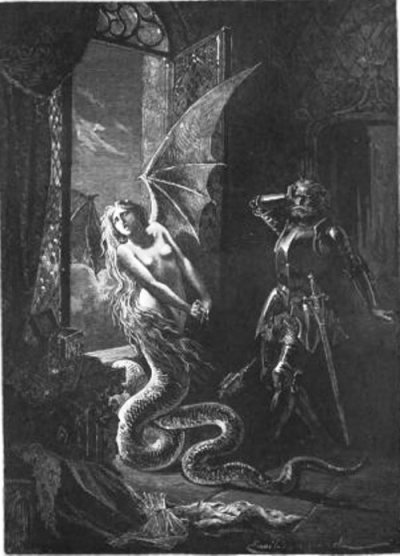 |
| [Art: ‘Melusine’, from “Les grandes Sataniques de l'histoire de la Légende” by Roland Brévannes, Select Bibliothèque, 1907] |
 |
| Maleficent (Disney 2014) |
This is a set of linked tweets (known as a 'thread') exploring the possibility of Maleficent (being a dragon-shape-shifter) as a modern variant of Melusine. (When Gypsy contributes fresh content, she will inevitably find a way to reference fairy tales, no matter what the theme is.) We, too, believe there is a fairy tale link to every topic and situation under the sun...
With Maleficent: Mistress of Evil opening in theaters today, we thought it might be fun to expand the thread for a blog post, even though it has no real bearing on the Disney's live-action Maleficent movies... or does it?
 |
| Melusine and Raymon by Troy Howell |
(Description via Storytelling Toronto):
Melusine is both a mythic and historical character in French legend. She is best known for her secret: that every Saturday, she had to disappear into the bath, where the lower part of her body took on the form of a serpent.
Melusine was a great queen and benefactress. Her mother was a “maiden of the wells,” a fairy from the “Lost Isles” of Avalon. Her father was a mortal king, the king of Albany, now Scotland. Melusine became entangled in mortal life, married, and had ten sons who were powerfully gifted and cursed. She was said to have built many cities and abbeys, some of which still exist in France. This mythic queen left her imprint on the physical landscape of France and Scotland, and her baffling story draws us back to early Christianity and the demonization of the enchantress.^
 |
| Melusine escaping: Cover of 'The Legend of Melusine' (French) by Michèle Perret (artist unknown) |
In the meantime, we remain thrilled that some medieval literature and legend experts had also found a connection to Maleficent, taken their scholarly skills, time and effort to do comprehensive research, then published an exploration of the concept as part of their work. Their discussion of Maleficent's story having included some of the Melusine narrative in a modern form, though, is only a portion of one of the included papers in the book. From the excerpts we've been able to glimpse in previews, all other aspects are just as interesting. We are looking forward to the time we can read it in full. (Details and links at the end of post.)
Enjoy!
* * *  * * *
* * *
Today's theme for #MythologyMonday (August 29, 2019) is #MythologicalCreatures, so let's talk shapeshifting dragons, female ones; especially one in particular: Maleficent, but not as she's usually considered. * * *
* * *
Imagine Maleficent as a 'modern' day Melusine, as some versions of the legend say Melusine was. (Not a mermaid, or typical fairy, but perhaps a type of fairy-wyvern hybrid, which fits with the text).
Now imagine Melusine/Maleficent as a younger, more innocent creature. One day, when she was happily wandering in the woods, she met -some versions say rescued- a young French lord, Raymond of Poitou, and they fell in love.
Before long they were to be married. He didn't know she was Other and, in love, promised to give her the privacy of a private bath on Saturdays - with no peeking - ever!
Melusine was a prize for the Nobleman; not only was she beautiful, she made him 'lucky'. In reality, she used her dragon-hoarding abilities to attract wealth & built castles for him. She was very fertile, giving him ten children, with not a single hybrid among them to give her away, though they did have unusually large teeth and brilliant eyes...**
But Melusine's husband (Raymond) had a jealous brother who 'bedeviled' Ray with doubts about Melusine's faithfulness. Eventually (after at least ten children had been born) Ray gave in to his brother's decade-plus of mind-poisoning, and he finally broke his promise to Melusine, spying on her. He discovered her in her marble bath in partial-dragon form and, his mind already set against her, recoiled in horror.
Betrayed and heartbroken, Melusine spread her dragon wings as she backed away to the nearest window then, with a cry, fled the castle forever.
Though poor Melusine had fled for her life, she was heartbroken and missed her family. It was said she could sometimes be spotted, high above the castle, weeping. (Legend says you can still see her on moonless nights.)
Some say Melusine was a fairy, or mermaid or a serpent but don't believe it - she was a dragoness.
Did Melusine end up taking residence in a castle that crumbled to ruin over time and failing fortunes?
Did she become bitter and cynical about true love, vowing to thwart foolish young noble women, cursing them to sleep before they could have their freedom -and their love- betrayed?
And did she finally give in completely to her true draconic nature when a young princess, hailed the Dawn of the New Age+, was about to make the same mistake she once had in the woods, only to tragically become a trophy once again, only this time on a Prince's wall?
We'll never truly know. All we can say in certainty is that loving a dragoness is not for the faint of heart.
#MythologyMonday #Maleficent
[To trace more scholarly musings on Melusine, this book may be of interest: "Melusine’s Footprint: Tracing the Legacy of a Medieval Myth"]
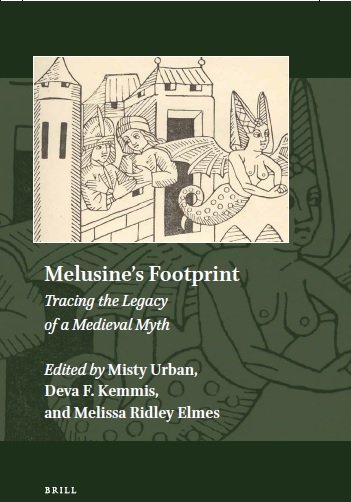
[From Misty Urban's paper: How the Dragon Ate the Woman: The Fate of Melusine in English:]
And if you go see Melusine, er Maleficent: Mistress of Evil in theaters this weekend, drop us a line, a comment or tag @inkgypsy on Twitter, and let us know your impressions.
^ You can read a more detailed story-like summary of Melusine, including why she had to bathe every Saturday in semi-dragon form, HERE. (Note: the website is in French - Google translate gives you the gist but knowing some French helps!) Otherwise, Wikipedia's Melusine entry has a lot to offer and link you to, if you want to begin a "deep dive".
* In case you are interested in joining in on social media and saying 'hi', Gypsy does her best to visit three different Twitter weekly events (even if only briefly, or toward the end of the time frame). They are:
#MythologyMonday
#FairyTaleTuesday
#FolkloreThursday
Just put the hashtag in the search box to find all the tweets. Everyone is welcome to observe, tweet and contribute and each week usually has a theme, though off-topic mythology, folklore or fairy tale information, art, and questions are OK too. You can just search the hashtag and read without posting, or reply and have a discussion, or add a new tweet to the content - whatever you'd like. Just be sure to add that day's hashtag so people can see your comments. Each group has a lot of overlap and all of them are very friendly folks.
** Wondering what happened to those large-toothed, brilliant-eyed children? Here you go (via Castles, Celtics & Chimeras):
The Ten Children of MélusineMélusine gave Raymond ten sons. But the count, though very proud of having so many children, was not always very comfortable looking at them.
1st: Urian - who became king of Cyprus - was "in every way well-formed, except that he had a short and full face, a red eye and the other person [blue and green], and the largest ears that have never been seen to a child;
2nd: Eudes , had an unquestionably larger ear than the other ";
3rd: Guion , had "one eye higher than the other";
4th: Antoine, handsome and well made like his brothers, except that he wore "a lion's paw on the cheek, and before he was eight, he became hairy, with sharp claws"
5th: Renaud , had only one eye, but remarkably piercing;
6th: Geoffroy , had a 3 cm canine that came out of his mouth;
7th: Fromont , who became a monk at Maillezais, had a hairy spot on his nose;
8th: Horrible , incredibly tall, had three eyes, and he was so ferocious that before 4 years old he had killed 2 of his nannies ".
9th: Thierry , was normal;
10th: Raymonnet , was normal too.
+ Aurora (Disney's chosen "princess name" for Sleeping Beauty, who, in the animated classic, which Maleficent references, grows up being called 'Briar Rose', or just 'Rose' by the three fairies, Fauna, Flora and Merryweather.)
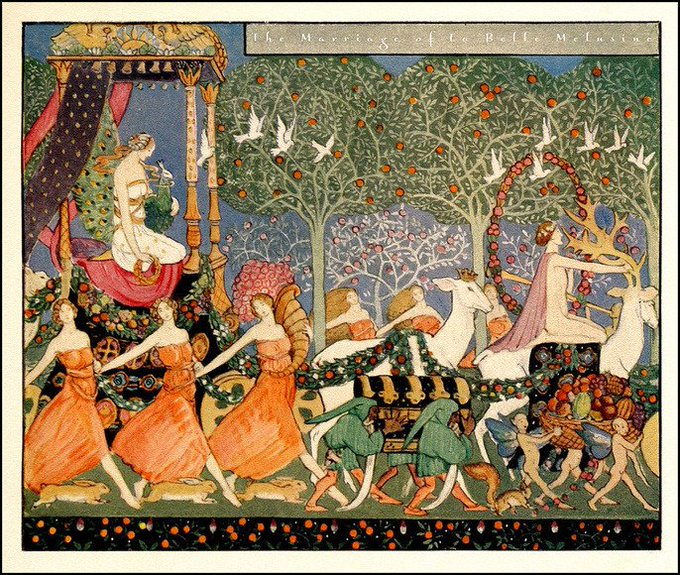 |
| [Art: The Marriage of Le Belle Melusine, Jessie Bayes, 1914] |
Before long they were to be married. He didn't know she was Other and, in love, promised to give her the privacy of a private bath on Saturdays - with no peeking - ever!
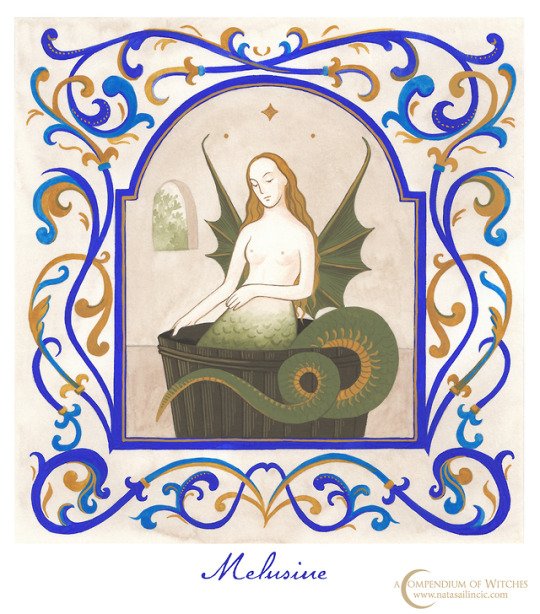 |
| [Art: Nataša Ilincic] |
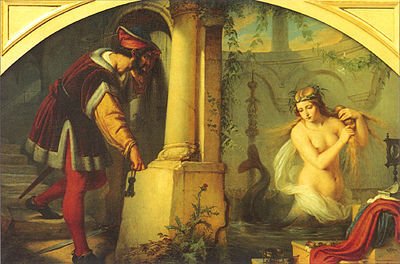 |
| [Art: Julius Hübner 'Die schöne Melusine' 1844] |
 |
| Melusine / Illumination, Flemish, c. 1410–1420, attributed to Guillebert de Mets. “Melusine s’enfuit transformée en vouivre” (Melusine flees disguised as a dragon). |
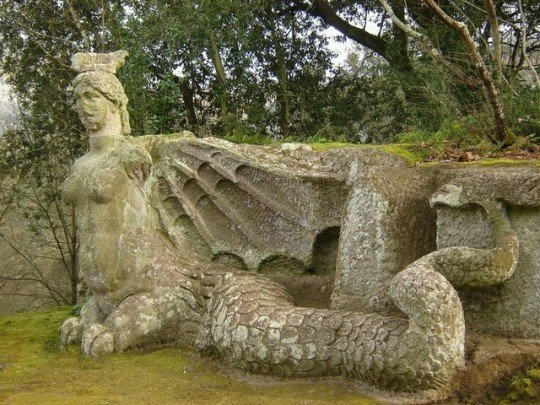 |
| [Art: The figure of Melusine, at the 16th century sculpture garden of Bomarzo, Italy.] |
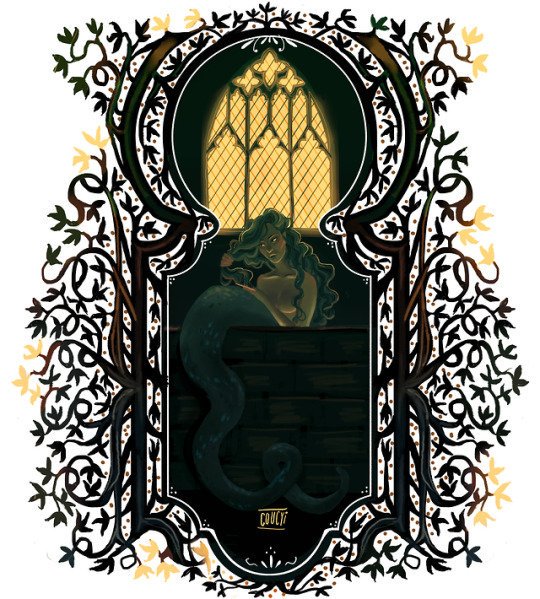 |
| [Art: by coucyi on Tumblr] |
Did she become bitter and cynical about true love, vowing to thwart foolish young noble women, cursing them to sleep before they could have their freedom -and their love- betrayed?
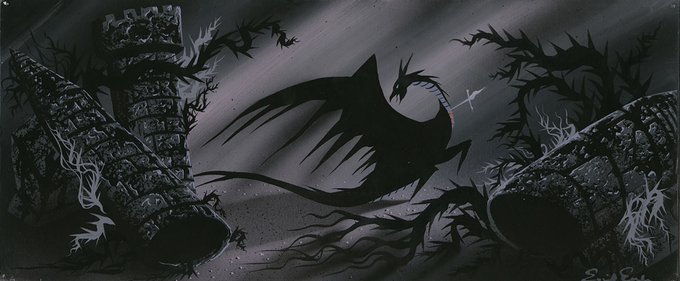 |
| [Art: Eyvind Earle concept painting of "Maleficent" as the Dragon from Sleeping Beauty. (Walt Disney, 1959) ] |
We'll never truly know. All we can say in certainty is that loving a dragoness is not for the faint of heart.
#MythologyMonday #Maleficent
[To trace more scholarly musings on Melusine, this book may be of interest: "Melusine’s Footprint: Tracing the Legacy of a Medieval Myth"]

Description:
Melusine's Footprint: Tracing the Legacy of a Medieval Myth
Editors: Misty Urban, Deva Kemmis, and Melissa Ridley Elmes
In Melusine’s Footprint: Tracing the Legacy of a Medieval Myth, editors Misty Urban, Deva Kemmis, and Melissa Ridley Elmes offer an invigorating international and interdisciplinary examination of the legendary fairy Melusine. Along with fresh insights into the popular French and German traditions, these essays investigate Melusine’s English, Dutch, Spanish, and Chinese counterparts and explore her roots in philosophy, folklore, and classical myth.
Combining approaches from art history, history, alchemy, literature, cultural studies, and medievalism, applying rigorous critical lenses ranging from feminism and comparative literature to film and monster theory, this volume brings Melusine scholarship into the twenty-first century with twenty lively and evocative essays that reassess this powerful figure’s multiple meanings and illuminate her dynamic resonances across cultures and time.
Contributors are Anna Casas Aguilar, Jennifer Alberghini, Frederika Bain, Anna-Lisa Baumeister, Albrecht Classen, Chera A. Cole, Tania M. Colwell, Zoë Enstone, Stacey L. Hahn, Deva F. Kemmis, Ana Pairet, Pit Péporté, Simone Peger, Caroline Prud’Homme, Melissa Ridley Elmes, Renata Schellenberg, Misty Urban, Angela Jane Weisl, Lydia Zeldenrust, and Zifeng Zhao.
* * *  * * *
* * *
 * * *
* * *
Almost a month after Gypsy's story thread, one of the editors, Dr. Melissa Ridley Elmes, added this tweet for the #FolkloreThursday theme of the week: Mythological Creatures
Since first finding Melusine's Footprint, we have tracked down some previews and excerpts that include discussion of Maleficent. Here's a small taste:I can't possibly let a #FolkloreThursday devoted to "mythological creatures" pass by without a shout-out to my darling Melusine, the medieval fairy who becomes a dragon when her husband betrays her by peeking in on her bath! @FolkloreThurs pic.twitter.com/2jvb4eo4v7— Dr. Melissa Ridley Elmes (@MRidleyElmes) August 29, 2019
[From Misty Urban's paper: How the Dragon Ate the Woman: The Fate of Melusine in English:]
... in what might so far be the closest reunion of the dragon and the woman on the screen of a blockbuster film: Disney's 2014 live-action Maleficent, which re-envisions the supernatural fairy enchantress of the Sleeping Beauty legend into a figure much like Melusine. With horns on her head highly reminiscent of the headdress Melusine wears in late medieval and early modern woodcuts, the fairy Maleficent otherwise appears human in form save for a pair of wings, of which she is deprived in the course of the movie by a false lover. The Maleficent of this film harbors strongly protective maternal instincts and is a powerful enchantress with unlimited resources who can physically transform her kingdom at will and who is its recognized ruler. While male betrayal is a prevalent motif, the emotional charge of the narrative rests on the way that the two central female characters lift the curse on each other: Maleficent herself breaks the curse of the death-like sleep she laid on Aurora, and an awakened Aurora consequently restores her wings to Maleficent, who, in a film moment highly evocative of Melusine's final exit transforms into winged creature, exits the castle that entraps her by shattering a stained-glass window, and then flies about the parapets, screaming, as she sends the malicious King Stefan to his death. [Urban pp. 386]
Urban's contribution reveals that the decades following second wave feminism have witnessed the return of a polymorphic Melusine in innovative new interpretations. Constrating with premodern tendencies to soften Melusine's hybridity, young adult fiction has endowed the fully serpentine character with an apotropaic role, while the metamorphic, aerial Maleficent, who sits at the heart of a Hollywood fantasy film exploring women's protective and destructive qualities, strikingly revels in her alterity. [Colwell, pp. 398]You can purchase the book HERE at the publisher's website. This includes a list of the papers included. Each 'locked link' still gives you a limited preview (after clicking on the chapter title), and is great food for thought, even just having a glimpse. Alternately you can find a copy (often cheaper) HERE on Amazon.
And if you go see Melusine, er Maleficent: Mistress of Evil in theaters this weekend, drop us a line, a comment or tag @inkgypsy on Twitter, and let us know your impressions.
^ You can read a more detailed story-like summary of Melusine, including why she had to bathe every Saturday in semi-dragon form, HERE. (Note: the website is in French - Google translate gives you the gist but knowing some French helps!) Otherwise, Wikipedia's Melusine entry has a lot to offer and link you to, if you want to begin a "deep dive".
 |
| ‘Melusine’, from “Les grandes Sataniques de l'histoire de la Légende” by Roland Brévannes, |
#MythologyMonday
#FairyTaleTuesday
#FolkloreThursday
Just put the hashtag in the search box to find all the tweets. Everyone is welcome to observe, tweet and contribute and each week usually has a theme, though off-topic mythology, folklore or fairy tale information, art, and questions are OK too. You can just search the hashtag and read without posting, or reply and have a discussion, or add a new tweet to the content - whatever you'd like. Just be sure to add that day's hashtag so people can see your comments. Each group has a lot of overlap and all of them are very friendly folks.
** Wondering what happened to those large-toothed, brilliant-eyed children? Here you go (via Castles, Celtics & Chimeras):
The Ten Children of MélusineMélusine gave Raymond ten sons. But the count, though very proud of having so many children, was not always very comfortable looking at them.
1st: Urian - who became king of Cyprus - was "in every way well-formed, except that he had a short and full face, a red eye and the other person [blue and green], and the largest ears that have never been seen to a child;
2nd: Eudes , had an unquestionably larger ear than the other ";
3rd: Guion , had "one eye higher than the other";
4th: Antoine, handsome and well made like his brothers, except that he wore "a lion's paw on the cheek, and before he was eight, he became hairy, with sharp claws"
5th: Renaud , had only one eye, but remarkably piercing;
6th: Geoffroy , had a 3 cm canine that came out of his mouth;
7th: Fromont , who became a monk at Maillezais, had a hairy spot on his nose;
8th: Horrible , incredibly tall, had three eyes, and he was so ferocious that before 4 years old he had killed 2 of his nannies ".
9th: Thierry , was normal;
10th: Raymonnet , was normal too.
+ Aurora (Disney's chosen "princess name" for Sleeping Beauty, who, in the animated classic, which Maleficent references, grows up being called 'Briar Rose', or just 'Rose' by the three fairies, Fauna, Flora and Merryweather.)







































